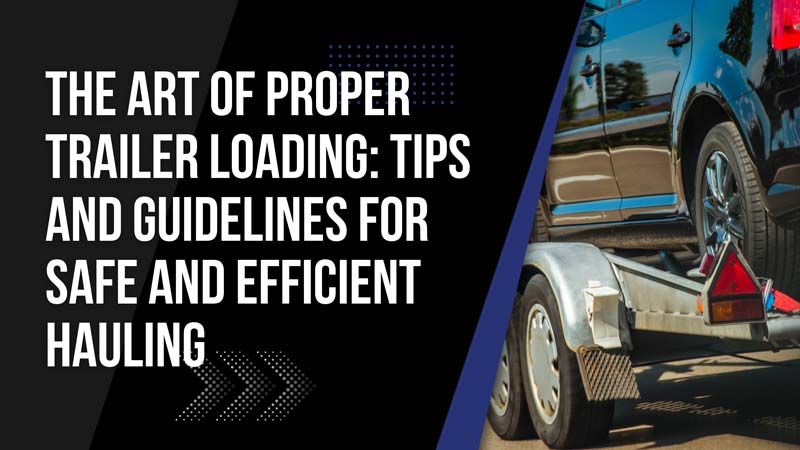The Art of Proper Trailer Loading: Tips and Guidelines for Safe and Efficient Hauling

Before diving into the specifics of trailer loading techniques, it's important to understand the basic principles behind balancing and distributing cargo weight. Proper weight distribution plays a significant role in the stability and handling of your trailer, directly impacting your driving experience on the road. In general, it's recommended to distribute the majority of the cargo weight toward the front of the trailer, with approximately 60% of the load placed in front of the axle(s) and the remaining 40% behind it. This weight distribution pattern helps maintain the correct amount of tongue weight, preventing sway and unstable towing conditions.
Understanding Basic Principles of Weight Distribution
Before diving into the specifics of trailer loading techniques, it's important to understand the basic principles behind balancing and distributing cargo weight. Proper weight distribution plays a significant role in the stability and handling of your trailer, directly impacting your driving experience on the road. In general, it's recommended to distribute the majority of the cargo weight toward the front of the trailer, with approximately 60% of the load placed in front of the axle(s) and the remaining 40% behind it. This weight distribution pattern helps maintain the correct amount of tongue weight, preventing sway and unstable towing conditions.
Adhering to Weight Limitations and Ratings
Moreover, understanding the weight limitations of your trailer and tow vehicle is essential for preventing overloading, which can not only cause trailer and vehicle damage but also lead to serious road accidents. Always adhere to the Gross Vehicle Weight Rating (GVWR) and the Gross Axle Weight Rating (GAWR) specified for your specific trailer model, as well as the towing capacity of your tow vehicle.
Practical Tips for Proper Trailer Loading
- Prepare Your Trailer and Cargo
Before starting the loading process, ensure that your trailer and cargo are clean, organized, and ready for loading. Inspect the trailer's surface for any debris, dirt, or obstacles that could interfere with proper loading or create safety hazards. Ensure that your cargo is properly packaged and sorted, taking extra care to protect fragile items and prevent them from shifting during transit. - Arrange Cargo According to Weight Distribution Guidelines
When placing your cargo onto the trailer, be mindful of the recommended weight distribution guidelines. Place heavier items near the front of the trailer and lighter items towards the rear, ensuring that the majority of the weight remains in front of the axle(s). This arrangement technique will help achieve proper tongue weight and prevent trailer sway during transportation. - Secure Your Cargo with Appropriate Tie-Downs and Anchor Points
Properly securing your cargo is essential for preventing it from shifting, which can lead to accidents and damages. Utilize tie-downs, such as ratchet straps or bungee cords, to secure your load to the trailer, making sure to fasten them tightly and evenly. Additionally, use anchor points, like D-rings or E-track systems, as secure attachment locations for your tie-downs. Remember to periodically check your tie-downs throughout your journey to ensure they remain tight and secure. - Conduct Pre-Trip Inspections and Weight Checks
Once your cargo is properly loaded and secured, it's crucial to perform a comprehensive pre-trip inspection. Check that your trailer lights, brakes, and reflectors are functioning correctly, and inspect your tires for adequate inflation and wear. Additionally, ensure that your hitch assembly and safety chains are properly attached and secured. Finally, verify that your loaded trailer does not exceed the GVWR, GAWR, or your tow vehicle's towing capacity by weighing your trailer at a certified scale. Keep in mind that exceeding weight limitations can result in fines, decreased fuel efficiency, and potential damage to your trailer and tow vehicle.
Conclusion
Proper trailer loading is an essential aspect of safe and efficient hauling, requiring a thorough understanding of weight distribution principles and weight limitations. By following practical tips and guidelines for arranging cargo, securing items, and conducting pre-trip inspections, you can confidently transport your cargo securely and reduce the risks associated with improper loading techniques.
If you have any questions about proper trailer loading techniques or need expert advice on selecting the ideal trailer for your specific hauling needs, be sure to reach out to us at I-Deal Trailers. Our knowledgeable team is always here to help you make the most of your towing experiences and ensure your success in all your hauling endeavors. Browse heavy-duty equipment trailers here.
About Us
Are you looking for a reliable company to buy a trailer for your next project? Look no further than I-Deal Trailers. We are a family-owned and managed business based in Wake Forest, NC. And we have everything you need in terms of trailers, whether it is a utility trailer, a dump trailer, or even a gooseneck trailer. We’ve got you covered.We also help provide financing options to our clients. You can reach us at (919) 554-6266 or fill out our contact form to learn more.

